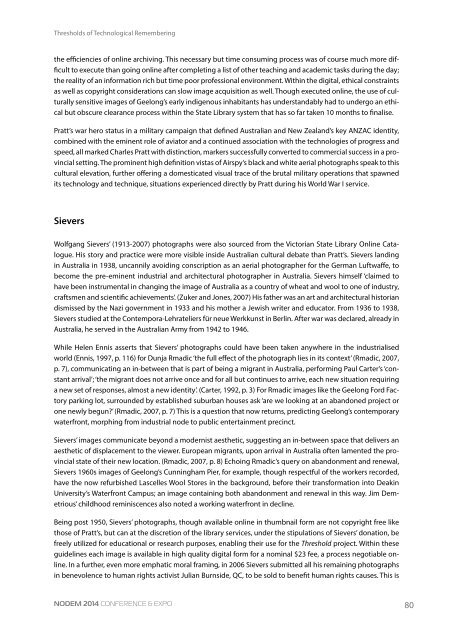NODEM 2014 Proceedings
NODEM 2014 Proceedings
NODEM 2014 Proceedings
Create successful ePaper yourself
Turn your PDF publications into a flip-book with our unique Google optimized e-Paper software.
Thresholds of Technological Remembering<br />
the efficiencies of online archiving. This necessary but time consuming process was of course much more difficult<br />
to execute than going online after completing a list of other teaching and academic tasks during the day;<br />
the reality of an information rich but time poor professional environment. Within the digital, ethical constraints<br />
as well as copyright considerations can slow image acquisition as well. Though executed online, the use of culturally<br />
sensitive images of Geelong’s early indigenous inhabitants has understandably had to undergo an ethical<br />
but obscure clearance process within the State Library system that has so far taken 10 months to finalise.<br />
Pratt’s war hero status in a military campaign that defined Australian and New Zealand’s key ANZAC identity,<br />
combined with the eminent role of aviator and a continued association with the technologies of progress and<br />
speed, all marked Charles Pratt with distinction, markers successfully converted to commercial success in a provincial<br />
setting. The prominent high definition vistas of Airspy’s black and white aerial photographs speak to this<br />
cultural elevation, further offering a domesticated visual trace of the brutal military operations that spawned<br />
its technology and technique, situations experienced directly by Pratt during his World War I service.<br />
Sievers<br />
Wolfgang Sievers’ (1913-2007) photographs were also sourced from the Victorian State Library Online Catalogue.<br />
His story and practice were more visible inside Australian cultural debate than Pratt’s. Sievers landing<br />
in Australia in 1938, uncannily avoiding conscription as an aerial photographer for the German Luftwaffe, to<br />
become the pre-eminent industrial and architectural photographer in Australia. Sievers himself ‘claimed to<br />
have been instrumental in changing the image of Australia as a country of wheat and wool to one of industry,<br />
craftsmen and scientific achievements’. (Zuker and Jones, 2007) His father was an art and architectural historian<br />
dismissed by the Nazi government in 1933 and his mother a Jewish writer and educator. From 1936 to 1938,<br />
Sievers studied at the Contempora-Lehrateliers für neue Werkkunst in Berlin. After war was declared, already in<br />
Australia, he served in the Australian Army from 1942 to 1946.<br />
While Helen Ennis asserts that Sievers’ photographs could have been taken anywhere in the industrialised<br />
world (Ennis, 1997, p. 116) for Dunja Rmadic ‘the full effect of the photograph lies in its context’ (Rmadic, 2007,<br />
p. 7), communicating an in-between that is part of being a migrant in Australia, performing Paul Carter’s ‘constant<br />
arrival’; ‘the migrant does not arrive once and for all but continues to arrive, each new situation requiring<br />
a new set of responses, almost a new identity’. (Carter, 1992, p. 3) For Rmadic images like the Geelong Ford Factory<br />
parking lot, surrounded by established suburban houses ask ‘are we looking at an abandoned project or<br />
one newly begun?’ (Rmadic, 2007, p. 7) This is a question that now returns, predicting Geelong’s contemporary<br />
waterfront, morphing from industrial node to public entertainment precinct.<br />
Sievers’ images communicate beyond a modernist aesthetic, suggesting an in-between space that delivers an<br />
aesthetic of displacement to the viewer. European migrants, upon arrival in Australia often lamented the provincial<br />
state of their new location. (Rmadic, 2007, p. 8) Echoing Rmadic’s query on abandonment and renewal,<br />
Sievers 1960s images of Geelong’s Cunningham Pier, for example, though respectful of the workers recorded,<br />
have the now refurbished Lascelles Wool Stores in the background, before their transformation into Deakin<br />
University’s Waterfront Campus; an image containing both abandonment and renewal in this way. Jim Demetrious’<br />
childhood reminiscences also noted a working waterfront in decline.<br />
Being post 1950, Sievers’ photographs, though available online in thumbnail form are not copyright free like<br />
those of Pratt’s, but can at the discretion of the library services, under the stipulations of Sievers’ donation, be<br />
freely utilized for educational or research purposes, enabling their use for the Threshold project. Within these<br />
guidelines each image is available in high quality digital form for a nominal $23 fee, a process negotiable online.<br />
In a further, even more emphatic moral framing, in 2006 Sievers submitted all his remaining photographs<br />
in benevolence to human rights activist Julian Burnside, QC, to be sold to benefit human rights causes. This is<br />
<strong>NODEM</strong> <strong>2014</strong> Conference & Expo<br />
80


